Attached files
| file | filename |
|---|---|
| EX-99.1 - EXHIBIT 99.1 - PINNACLE WEST CAPITAL CORP | pnw201706308kexhibit991.htm |
| 8-K - 8-K - PINNACLE WEST CAPITAL CORP | a8-kfor63017earnings.htm |
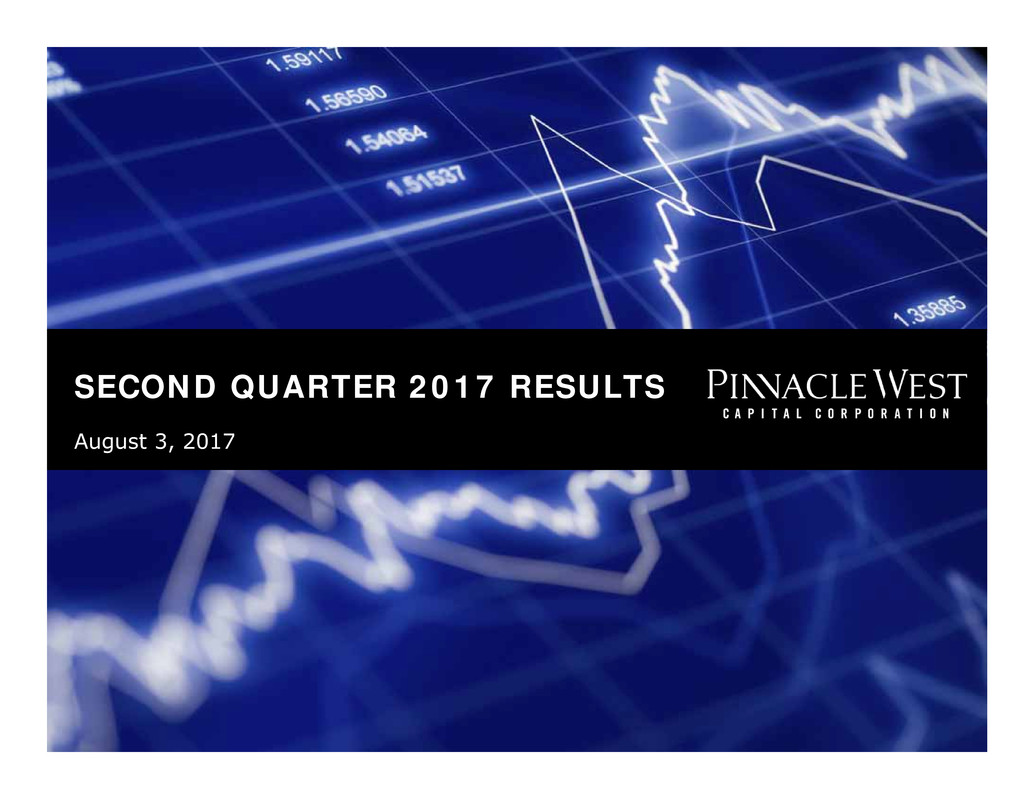
Second Quarter 2017
SECOND QUARTER 2017 RESULTS
August 3, 2017
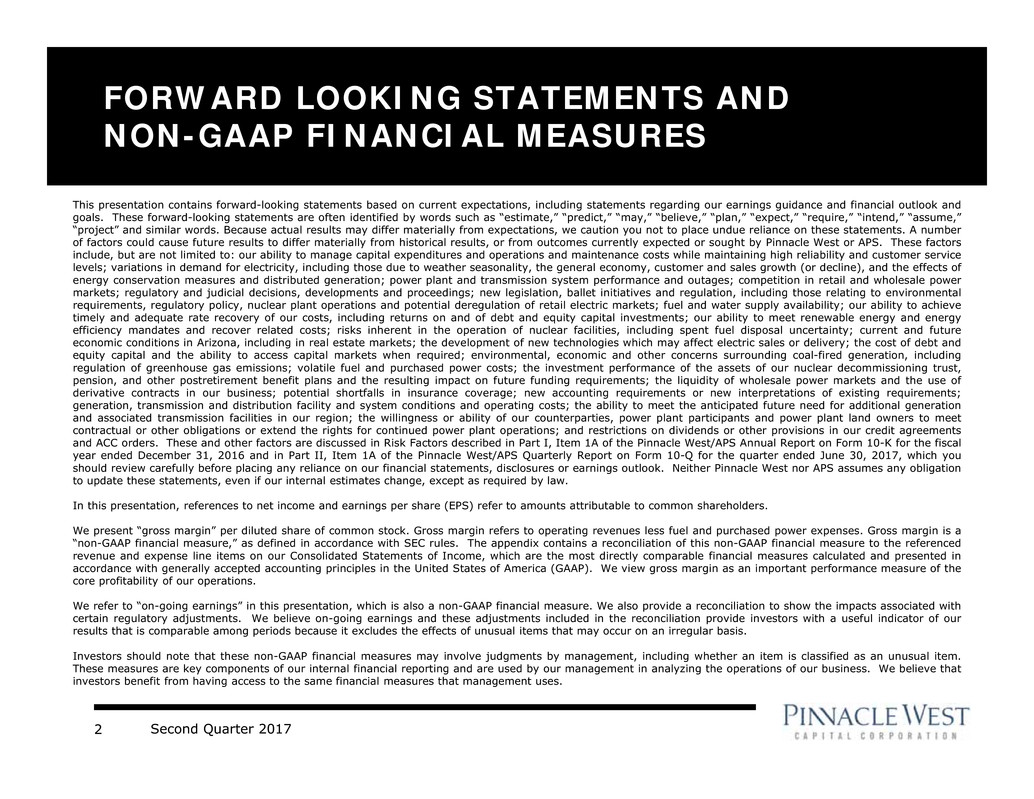
Second Quarter 20172
FORWARD LOOKING STATEMENTS AND
NON-GAAP FINANCIAL MEASURES
This presentation contains forward-looking statements based on current expectations, including statements regarding our earnings guidance and financial outlook and
goals. These forward-looking statements are often identified by words such as “estimate,” “predict,” “may,” “believe,” “plan,” “expect,” “require,” “intend,” “assume,”
“project” and similar words. Because actual results may differ materially from expectations, we caution you not to place undue reliance on these statements. A number
of factors could cause future results to differ materially from historical results, or from outcomes currently expected or sought by Pinnacle West or APS. These factors
include, but are not limited to: our ability to manage capital expenditures and operations and maintenance costs while maintaining high reliability and customer service
levels; variations in demand for electricity, including those due to weather seasonality, the general economy, customer and sales growth (or decline), and the effects of
energy conservation measures and distributed generation; power plant and transmission system performance and outages; competition in retail and wholesale power
markets; regulatory and judicial decisions, developments and proceedings; new legislation, ballet initiatives and regulation, including those relating to environmental
requirements, regulatory policy, nuclear plant operations and potential deregulation of retail electric markets; fuel and water supply availability; our ability to achieve
timely and adequate rate recovery of our costs, including returns on and of debt and equity capital investments; our ability to meet renewable energy and energy
efficiency mandates and recover related costs; risks inherent in the operation of nuclear facilities, including spent fuel disposal uncertainty; current and future
economic conditions in Arizona, including in real estate markets; the development of new technologies which may affect electric sales or delivery; the cost of debt and
equity capital and the ability to access capital markets when required; environmental, economic and other concerns surrounding coal-fired generation, including
regulation of greenhouse gas emissions; volatile fuel and purchased power costs; the investment performance of the assets of our nuclear decommissioning trust,
pension, and other postretirement benefit plans and the resulting impact on future funding requirements; the liquidity of wholesale power markets and the use of
derivative contracts in our business; potential shortfalls in insurance coverage; new accounting requirements or new interpretations of existing requirements;
generation, transmission and distribution facility and system conditions and operating costs; the ability to meet the anticipated future need for additional generation
and associated transmission facilities in our region; the willingness or ability of our counterparties, power plant participants and power plant land owners to meet
contractual or other obligations or extend the rights for continued power plant operations; and restrictions on dividends or other provisions in our credit agreements
and ACC orders. These and other factors are discussed in Risk Factors described in Part I, Item 1A of the Pinnacle West/APS Annual Report on Form 10-K for the fiscal
year ended December 31, 2016 and in Part II, Item 1A of the Pinnacle West/APS Quarterly Report on Form 10-Q for the quarter ended June 30, 2017, which you
should review carefully before placing any reliance on our financial statements, disclosures or earnings outlook. Neither Pinnacle West nor APS assumes any obligation
to update these statements, even if our internal estimates change, except as required by law.
In this presentation, references to net income and earnings per share (EPS) refer to amounts attributable to common shareholders.
We present “gross margin” per diluted share of common stock. Gross margin refers to operating revenues less fuel and purchased power expenses. Gross margin is a
“non-GAAP financial measure,” as defined in accordance with SEC rules. The appendix contains a reconciliation of this non-GAAP financial measure to the referenced
revenue and expense line items on our Consolidated Statements of Income, which are the most directly comparable financial measures calculated and presented in
accordance with generally accepted accounting principles in the United States of America (GAAP). We view gross margin as an important performance measure of the
core profitability of our operations.
We refer to “on-going earnings” in this presentation, which is also a non-GAAP financial measure. We also provide a reconciliation to show the impacts associated with
certain regulatory adjustments. We believe on-going earnings and these adjustments included in the reconciliation provide investors with a useful indicator of our
results that is comparable among periods because it excludes the effects of unusual items that may occur on an irregular basis.
Investors should note that these non-GAAP financial measures may involve judgments by management, including whether an item is classified as an unusual item.
These measures are key components of our internal financial reporting and are used by our management in analyzing the operations of our business. We believe that
investors benefit from having access to the same financial measures that management uses.
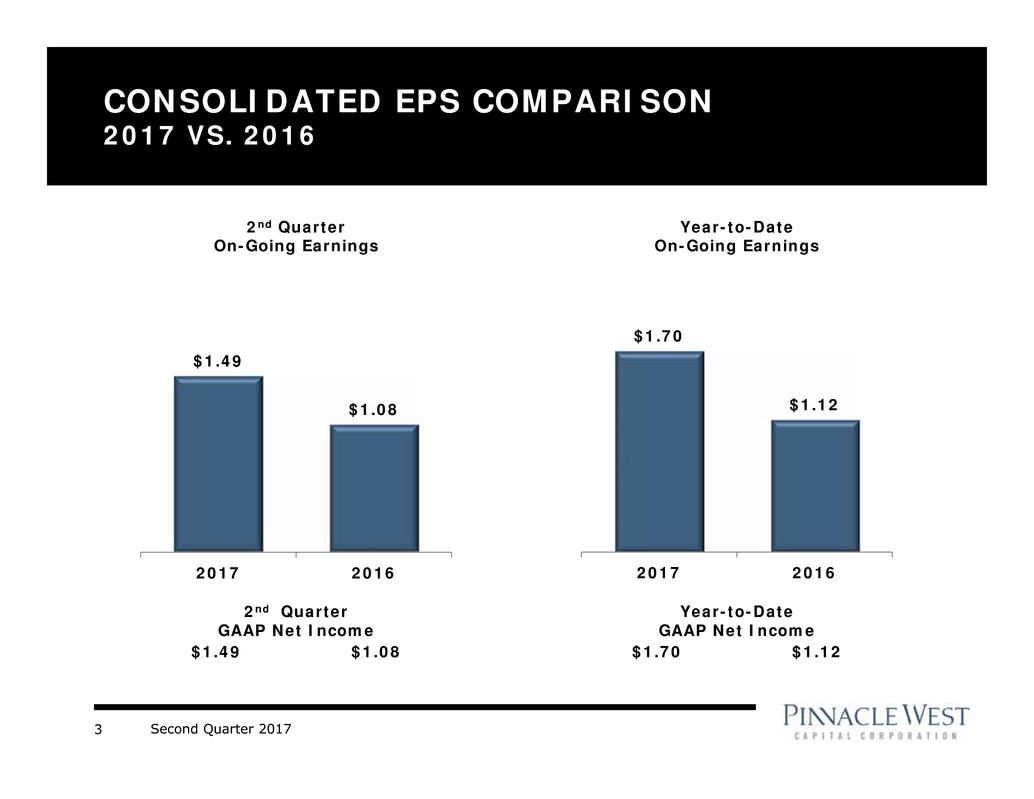
Second Quarter 20173
CONSOLIDATED EPS COMPARISON
2017 VS. 2016
$1.49
$1.08
2017 2016
2nd Quarter
GAAP Net Income
$1.49 $1.08
2nd Quarter
On-Going Earnings
$1.70
$1.12
2017 2016
Year-to-Date
GAAP Net Income
$1.70 $1.12
Year-to-Date
On-Going Earnings
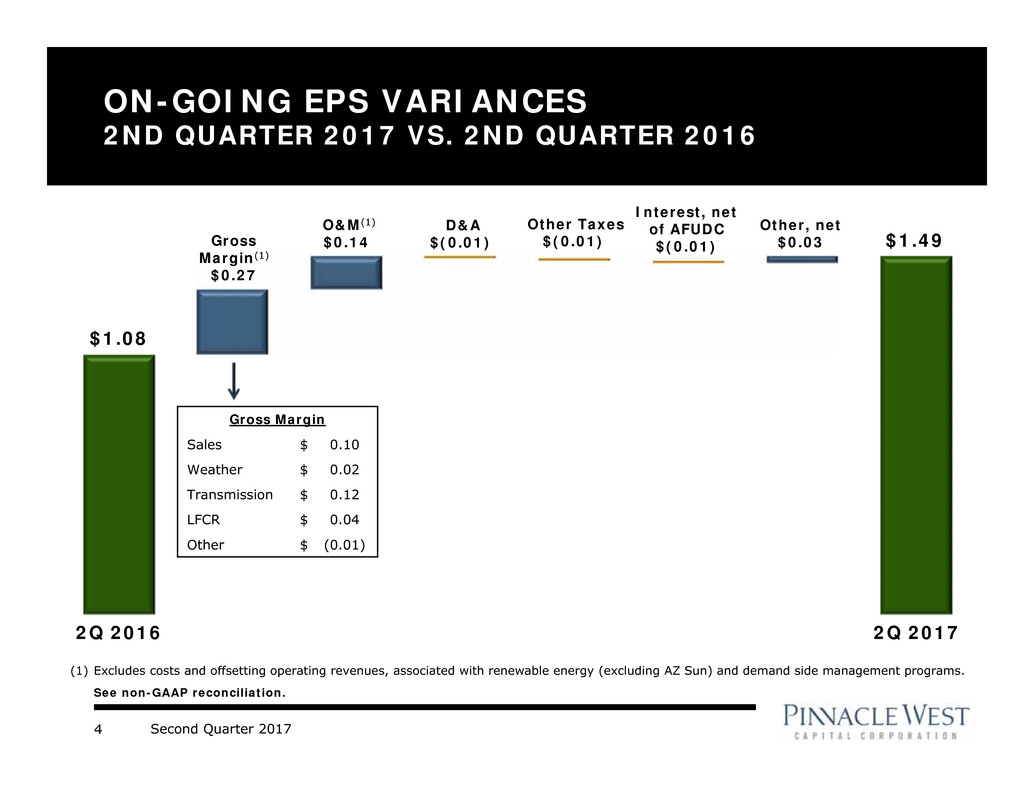
Second Quarter 20174
Gross
Margin(1)
$0.27
ON-GOING EPS VARIANCES
2ND QUARTER 2017 VS. 2ND QUARTER 2016
Other, net
$0.03
Interest, net
of AFUDC
$(0.01)
O&M(1)
$0.14
2Q 2016 2Q 2017
$1.08
$1.49
D&A
$(0.01)
(1) Excludes costs and offsetting operating revenues, associated with renewable energy (excluding AZ Sun) and demand side management programs.
See non-GAAP reconciliation.
Other Taxes
$(0.01)
Gross Margin
Sales $ 0.10
Weather $ 0.02
Transmission $ 0.12
LFCR $ 0.04
Other $ (0.01)
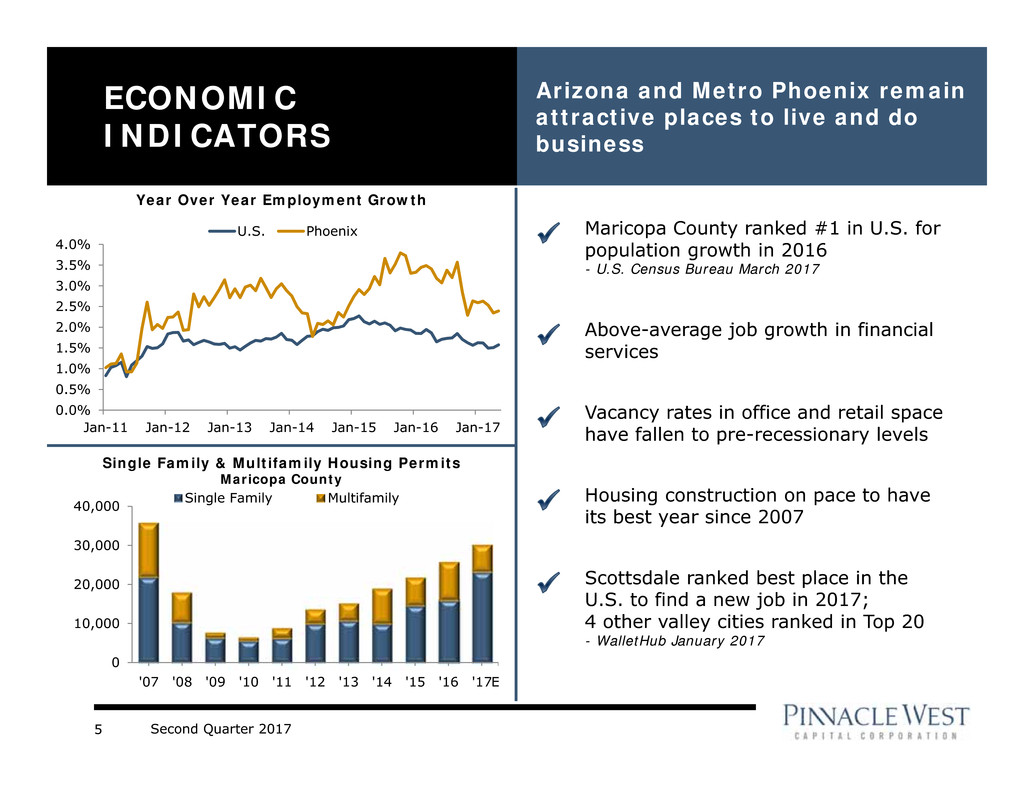
Second Quarter 20175
0
10,000
20,000
30,000
40,000
'07 '08 '09 '10 '11 '12 '13 '14 '15 '16 '17
Single Family Multifamily
ECONOMIC
INDICATORS
Arizona and Metro Phoenix remain
attractive places to live and do
business
Single Family & Multifamily Housing Permits
Maricopa County
Above-average job growth in financial
services
Maricopa County ranked #1 in U.S. for
population growth in 2016
- U.S. Census Bureau March 2017
E
Scottsdale ranked best place in the
U.S. to find a new job in 2017;
4 other valley cities ranked in Top 20
- WalletHub January 2017
Housing construction on pace to have
its best year since 2007
Vacancy rates in office and retail space
have fallen to pre-recessionary levels
Year Over Year Employment Growth
0.0%
0.5%
1.0%
1.5%
2.0%
2.5%
3.0%
3.5%
4.0%
Jan-11 Jan-12 Jan-13 Jan-14 Jan-15 Jan-16 Jan-17
U.S. Phoenix
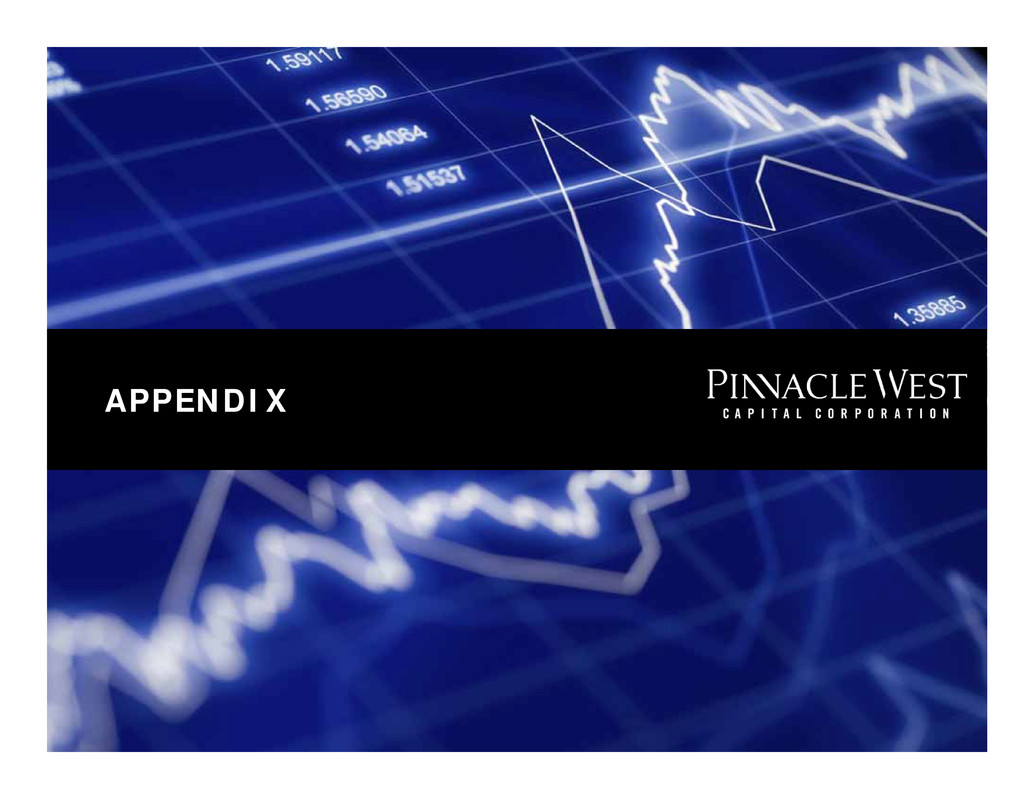
Second Quarter 2017
APPENDIX
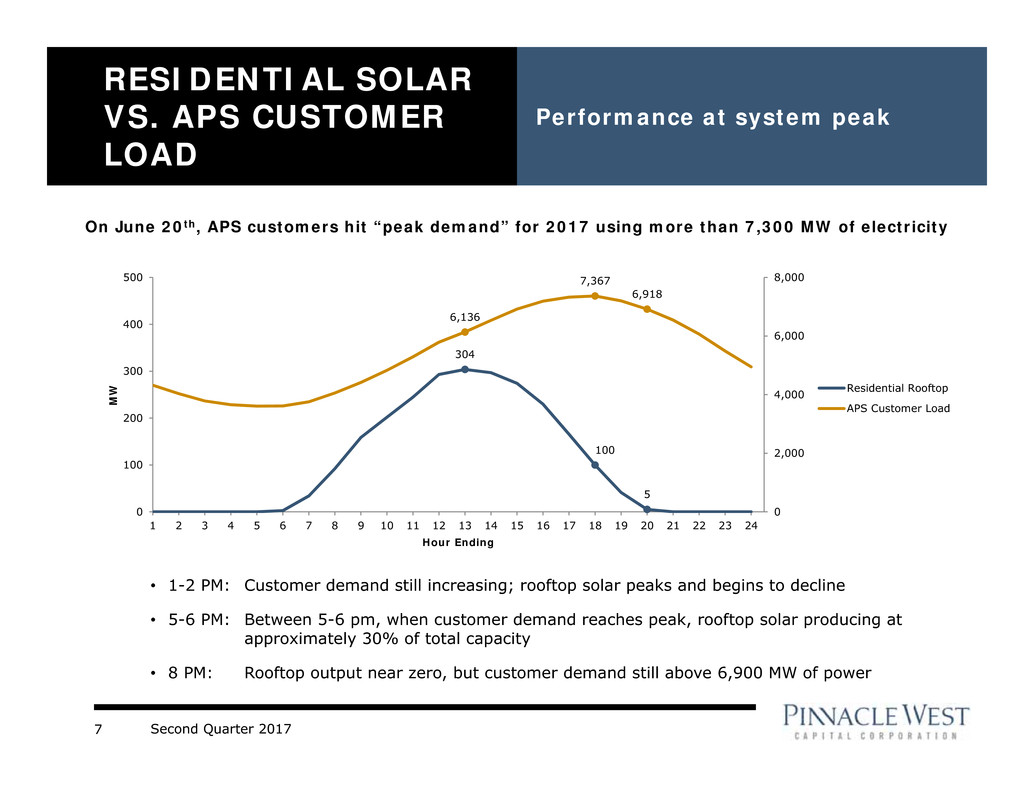
Second Quarter 20177
RESIDENTIAL SOLAR
VS. APS CUSTOMER
LOAD
Performance at system peak
On June 20th, APS customers hit “peak demand” for 2017 using more than 7,300 MW of electricity
304
100
5
6,136
7,367
6,918
0
2,000
4,000
6,000
8,000
0
100
200
300
400
500
1 2 3 4 5 6 7 8 9 10 11 12 13 14 15 16 17 18 19 20 21 22 23 24
M
W
Hour Ending
Residential Rooftop
APS Customer Load
• 1-2 PM: Customer demand still increasing; rooftop solar peaks and begins to decline
• 5-6 PM: Between 5-6 pm, when customer demand reaches peak, rooftop solar producing at
approximately 30% of total capacity
• 8 PM: Rooftop output near zero, but customer demand still above 6,900 MW of power
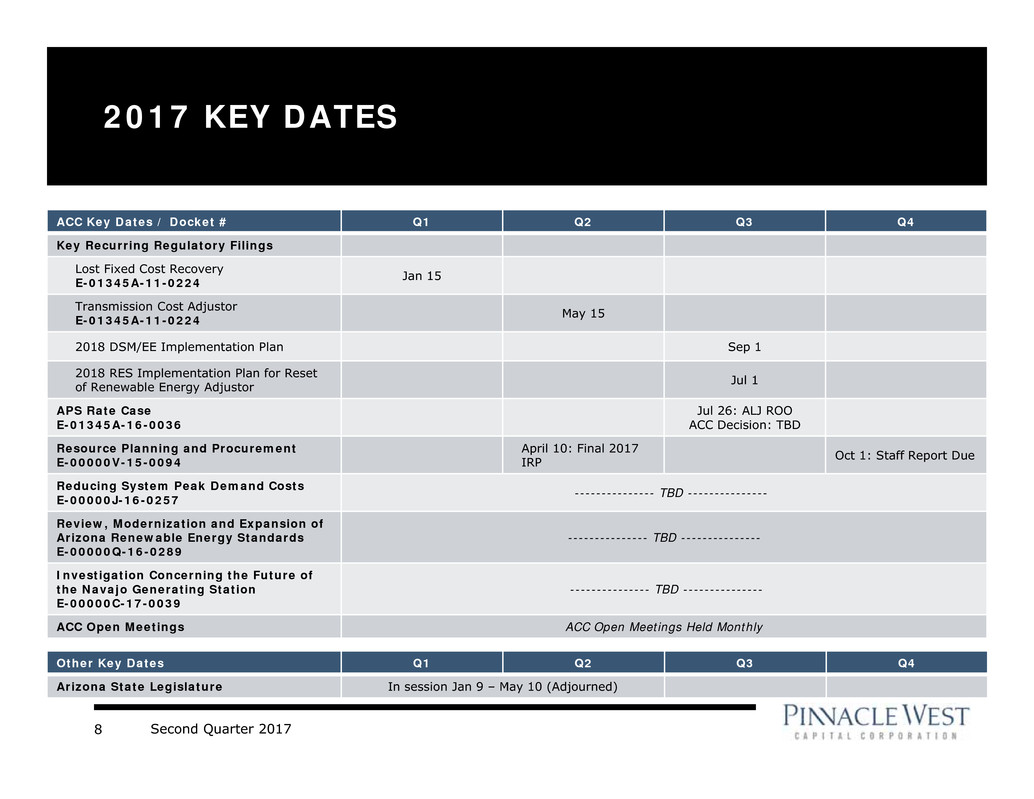
Second Quarter 20178
2017 KEY DATES
ACC Key Dates / Docket # Q1 Q2 Q3 Q4
Key Recurring Regulatory Filings
Lost Fixed Cost Recovery
E-01345A-11-0224 Jan 15
Transmission Cost Adjustor
E-01345A-11-0224 May 15
2018 DSM/EE Implementation Plan Sep 1
2018 RES Implementation Plan for Reset
of Renewable Energy Adjustor Jul 1
APS Rate Case
E-01345A-16-0036
Jul 26: ALJ ROO
ACC Decision: TBD
Resource Planning and Procurement
E-00000V-15-0094
April 10: Final 2017
IRP Oct 1: Staff Report Due
Reducing System Peak Demand Costs
E-00000J-16-0257 --------------- TBD ---------------
Review, Modernization and Expansion of
Arizona Renewable Energy Standards
E-00000Q-16-0289
--------------- TBD ---------------
Investigation Concerning the Future of
the Navajo Generating Station
E-00000C-17-0039
--------------- TBD ---------------
ACC Open Meetings ACC Open Meetings Held Monthly
Other Key Dates Q1 Q2 Q3 Q4
Arizona State Legislature In session Jan 9 – May 10 (Adjourned)
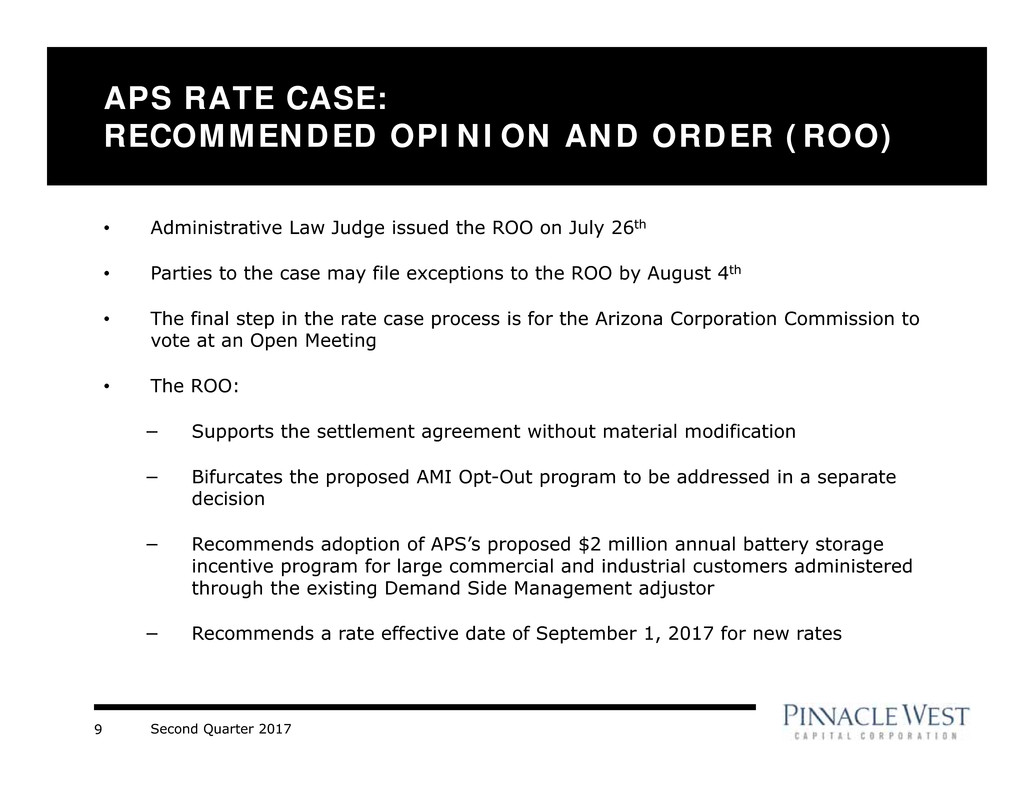
Second Quarter 20179
APS RATE CASE:
RECOMMENDED OPINION AND ORDER (ROO)
• Administrative Law Judge issued the ROO on July 26th
• Parties to the case may file exceptions to the ROO by August 4th
• The final step in the rate case process is for the Arizona Corporation Commission to
vote at an Open Meeting
• The ROO:
− Supports the settlement agreement without material modification
− Bifurcates the proposed AMI Opt-Out program to be addressed in a separate
decision
− Recommends adoption of APS’s proposed $2 million annual battery storage
incentive program for large commercial and industrial customers administered
through the existing Demand Side Management adjustor
− Recommends a rate effective date of September 1, 2017 for new rates
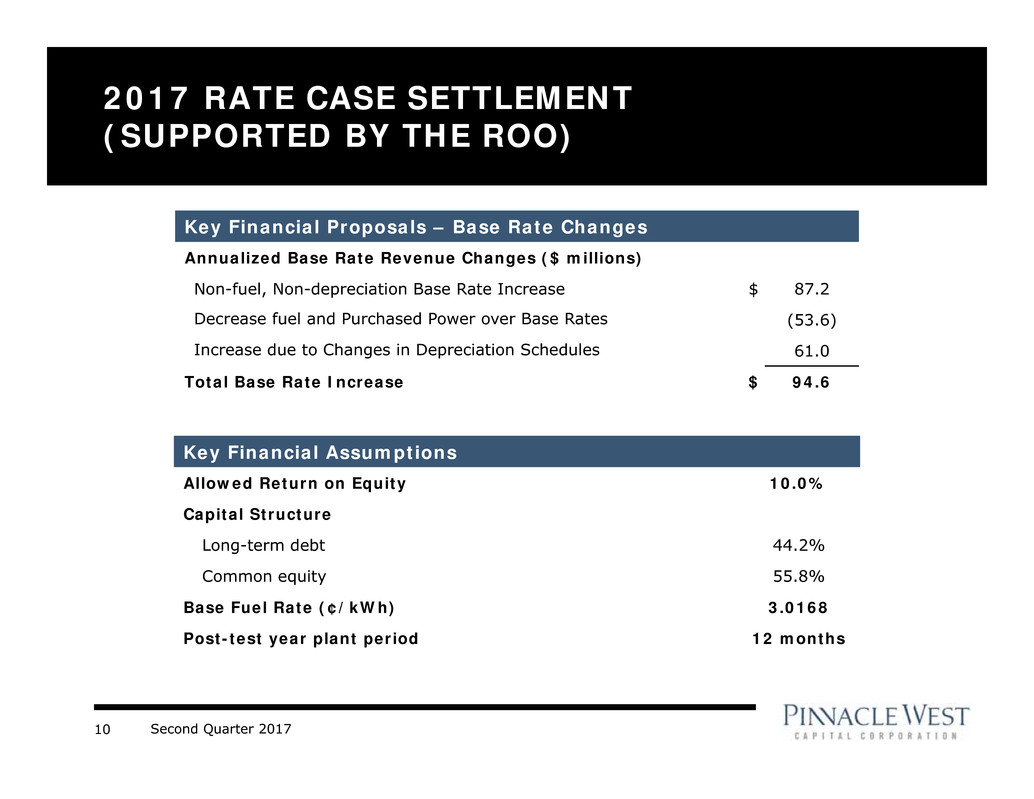
Second Quarter 201710
2017 RATE CASE SETTLEMENT
(SUPPORTED BY THE ROO)
Key Financial Proposals – Base Rate Changes
Annualized Base Rate Revenue Changes ($ millions)
Non-fuel, Non-depreciation Base Rate Increase $ 87.2
Decrease fuel and Purchased Power over Base Rates (53.6)
Increase due to Changes in Depreciation Schedules 61.0
Total Base Rate Increase $ 94.6
Key Financial Assumptions
Allowed Return on Equity 10.0%
Capital Structure
Long-term debt 44.2%
Common equity 55.8%
Base Fuel Rate (¢/kWh) 3.0168
Post-test year plant period 12 months
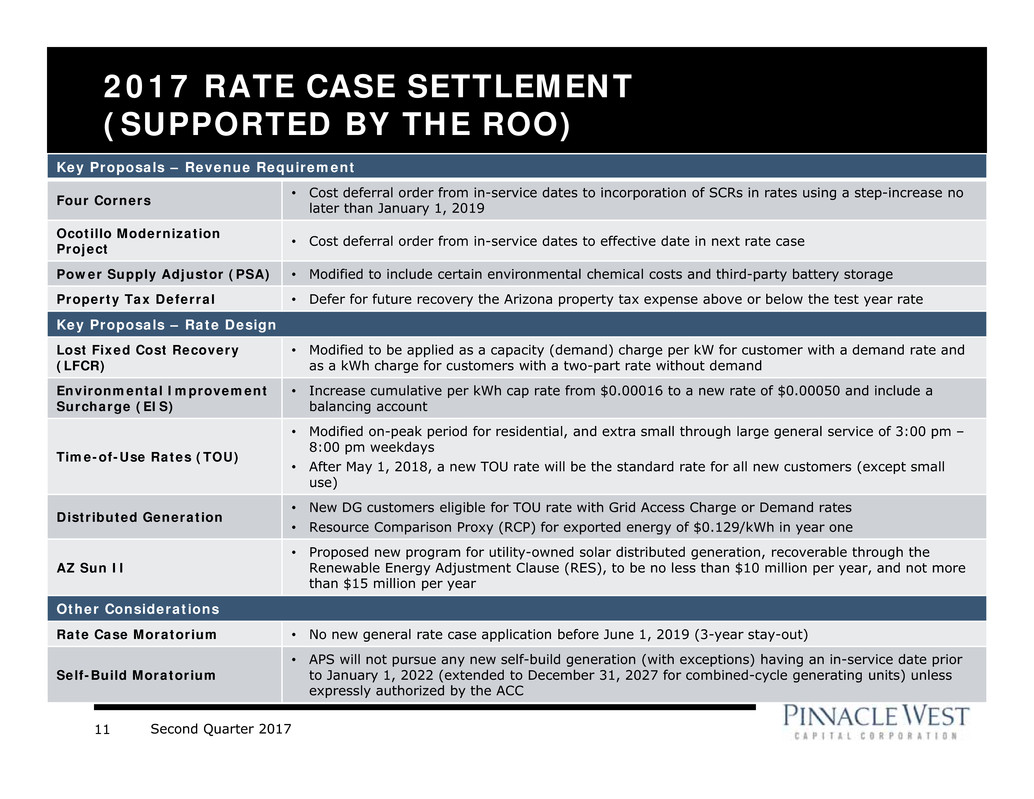
Second Quarter 201711
2017 RATE CASE SETTLEMENT
(SUPPORTED BY THE ROO)
Key Proposals – Revenue Requirement
Four Corners • Cost deferral order from in-service dates to incorporation of SCRs in rates using a step-increase no later than January 1, 2019
Ocotillo Modernization
Project • Cost deferral order from in-service dates to effective date in next rate case
Power Supply Adjustor (PSA) • Modified to include certain environmental chemical costs and third-party battery storage
Property Tax Deferral • Defer for future recovery the Arizona property tax expense above or below the test year rate
Key Proposals – Rate Design
Lost Fixed Cost Recovery
(LFCR)
• Modified to be applied as a capacity (demand) charge per kW for customer with a demand rate and
as a kWh charge for customers with a two-part rate without demand
Environmental Improvement
Surcharge (EIS)
• Increase cumulative per kWh cap rate from $0.00016 to a new rate of $0.00050 and include a
balancing account
Time-of-Use Rates (TOU)
• Modified on-peak period for residential, and extra small through large general service of 3:00 pm –
8:00 pm weekdays
• After May 1, 2018, a new TOU rate will be the standard rate for all new customers (except small
use)
Distributed Generation
• New DG customers eligible for TOU rate with Grid Access Charge or Demand rates
• Resource Comparison Proxy (RCP) for exported energy of $0.129/kWh in year one
AZ Sun II
• Proposed new program for utility-owned solar distributed generation, recoverable through the
Renewable Energy Adjustment Clause (RES), to be no less than $10 million per year, and not more
than $15 million per year
Other Considerations
Rate Case Moratorium • No new general rate case application before June 1, 2019 (3-year stay-out)
Self-Build Moratorium
• APS will not pursue any new self-build generation (with exceptions) having an in-service date prior
to January 1, 2022 (extended to December 31, 2027 for combined-cycle generating units) unless
expressly authorized by the ACC
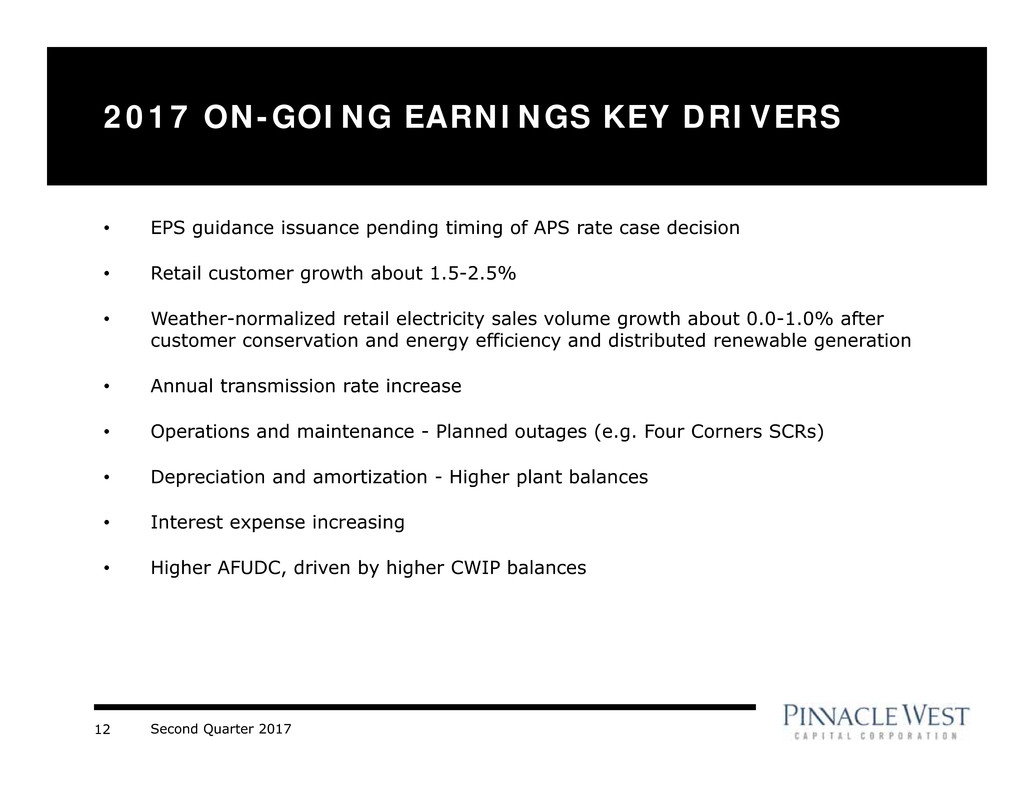
Second Quarter 201712
2017 ON-GOING EARNINGS KEY DRIVERS
• EPS guidance issuance pending timing of APS rate case decision
• Retail customer growth about 1.5-2.5%
• Weather-normalized retail electricity sales volume growth about 0.0-1.0% after
customer conservation and energy efficiency and distributed renewable generation
• Annual transmission rate increase
• Operations and maintenance - Planned outages (e.g. Four Corners SCRs)
• Depreciation and amortization - Higher plant balances
• Interest expense increasing
• Higher AFUDC, driven by higher CWIP balances
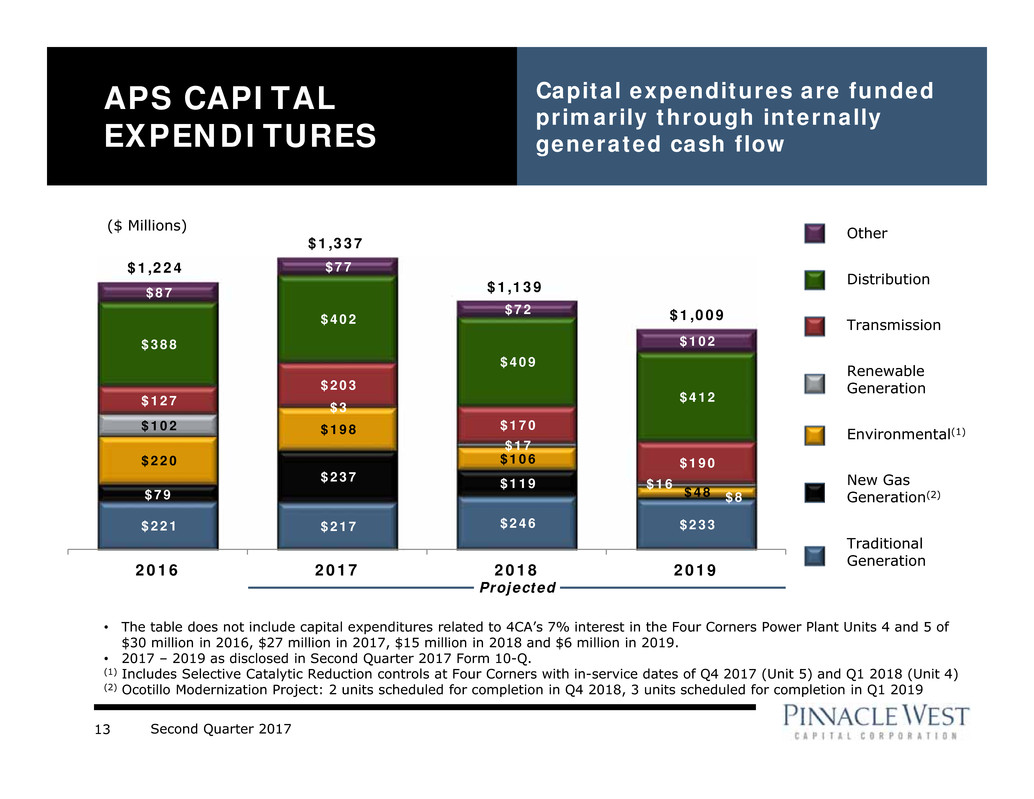
Second Quarter 201713
$221 $217 $246 $233
$79
$237 $119
$8
$220
$198
$106
$48
$102
$3
$17
$16
$127
$203
$170
$190
$388
$402
$409
$412
$87
$77
$72
$102
2016 2017 2018 2019
APS CAPITAL
EXPENDITURES
Capital expenditures are funded
primarily through internally
generated cash flow
($ Millions)
$1,224
$1,337
Other
Distribution
Transmission
Renewable
Generation
Environmental(1)
Traditional
Generation
Projected
$1,139
New Gas
Generation(2)
• The table does not include capital expenditures related to 4CA’s 7% interest in the Four Corners Power Plant Units 4 and 5 of
$30 million in 2016, $27 million in 2017, $15 million in 2018 and $6 million in 2019.
• 2017 – 2019 as disclosed in Second Quarter 2017 Form 10-Q.
(1) Includes Selective Catalytic Reduction controls at Four Corners with in-service dates of Q4 2017 (Unit 5) and Q1 2018 (Unit 4)
(2) Ocotillo Modernization Project: 2 units scheduled for completion in Q4 2018, 3 units scheduled for completion in Q1 2019
$1,009

Second Quarter 201714
OPERATIONS &
MAINTENANCE
Goal is to keep O&M per kWh flat,
adjusted for planned outages
$754 $761 $788
$805 $772
$828
$150 $124
$137 $103
$96
$83
2011 2012 2013 2014 2015 2016
PNW Consolidated RES/DSM*
*Renewable energy and demand side management expenses are offset by adjustment mechanisms.
($ Millions)
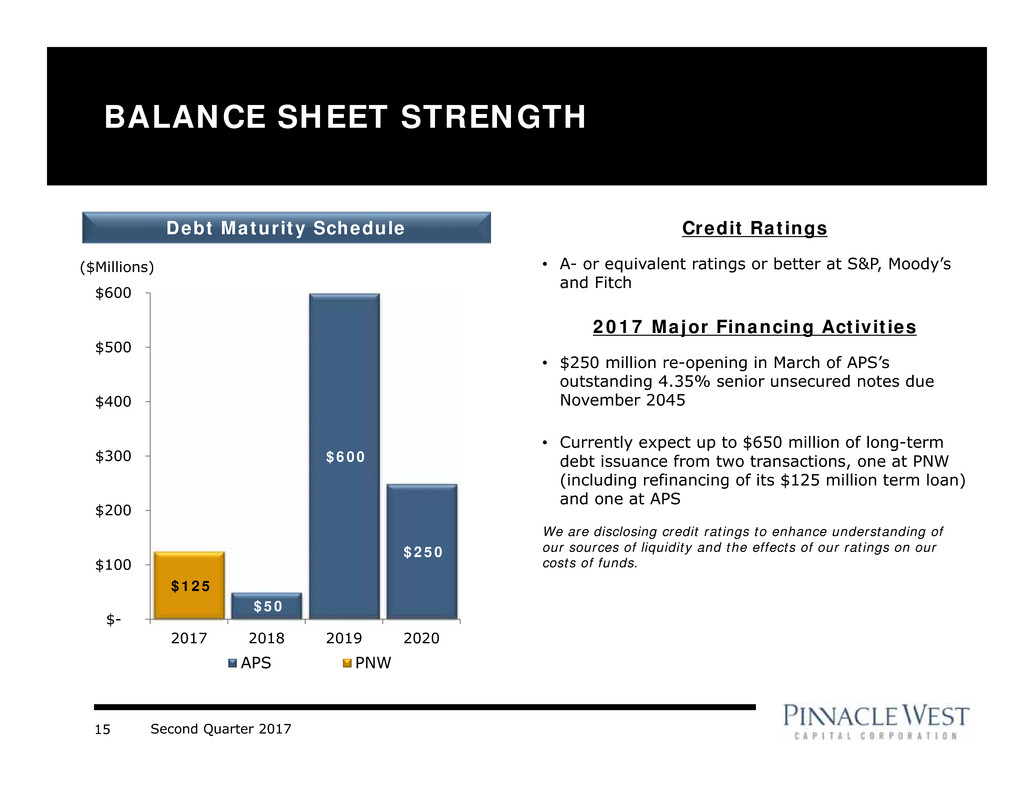
Second Quarter 201715
Credit Ratings
• A- or equivalent ratings or better at S&P, Moody’s
and Fitch
2017 Major Financing Activities
• $250 million re-opening in March of APS’s
outstanding 4.35% senior unsecured notes due
November 2045
• Currently expect up to $650 million of long-term
debt issuance from two transactions, one at PNW
(including refinancing of its $125 million term loan)
and one at APS
We are disclosing credit ratings to enhance understanding of
our sources of liquidity and the effects of our ratings on our
costs of funds.
BALANCE SHEET STRENGTH
$50
$600
$250
$125
$-
$100
$200
$300
$400
$500
$600
2017 2018 2019 2020
APS PNW
($Millions)
Debt Maturity Schedule
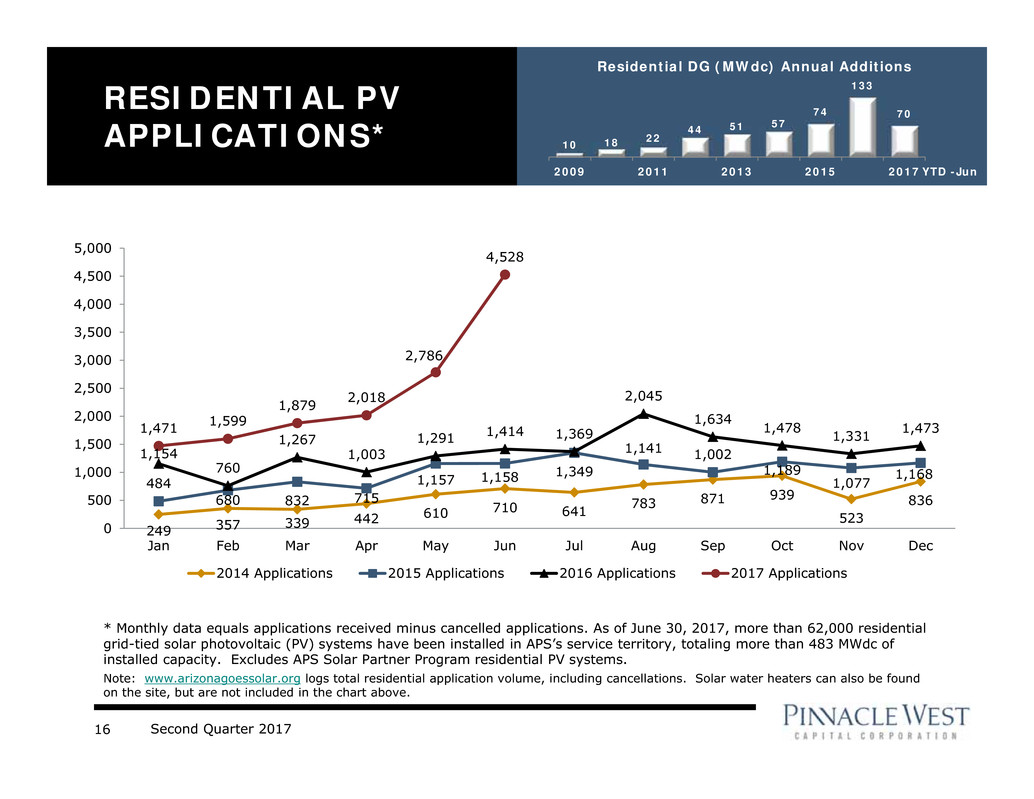
Second Quarter 201716
249 357 339
442 610
710 641 783
871 939
523
836
484
680 832 715
1,157 1,158 1,349
1,141 1,002
1,189
1,077
1,168
1,154
760
1,267
1,003
1,291 1,414 1,369
2,045
1,634
1,478 1,331 1,4731,471
1,599
1,879 2,018
2,786
4,528
0
500
1,000
1,500
2,000
2,500
3,000
3,500
4,000
4,500
5,000
Jan Feb Mar Apr May Jun Jul Aug Sep Oct Nov Dec
2014 Applications 2015 Applications 2016 Applications 2017 Applications
* Monthly data equals applications received minus cancelled applications. As of June 30, 2017, more than 62,000 residential
grid-tied solar photovoltaic (PV) systems have been installed in APS’s service territory, totaling more than 483 MWdc of
installed capacity. Excludes APS Solar Partner Program residential PV systems.
Note: www.arizonagoessolar.org logs total residential application volume, including cancellations. Solar water heaters can also be found
on the site, but are not included in the chart above.
RESIDENTIAL PV
APPLICATIONS* 10 18 22 44 51
57
74
133
70
2009 2011 2013 2015 2017
Residential DG (MWdc) Annual Additions
YTD -Jun
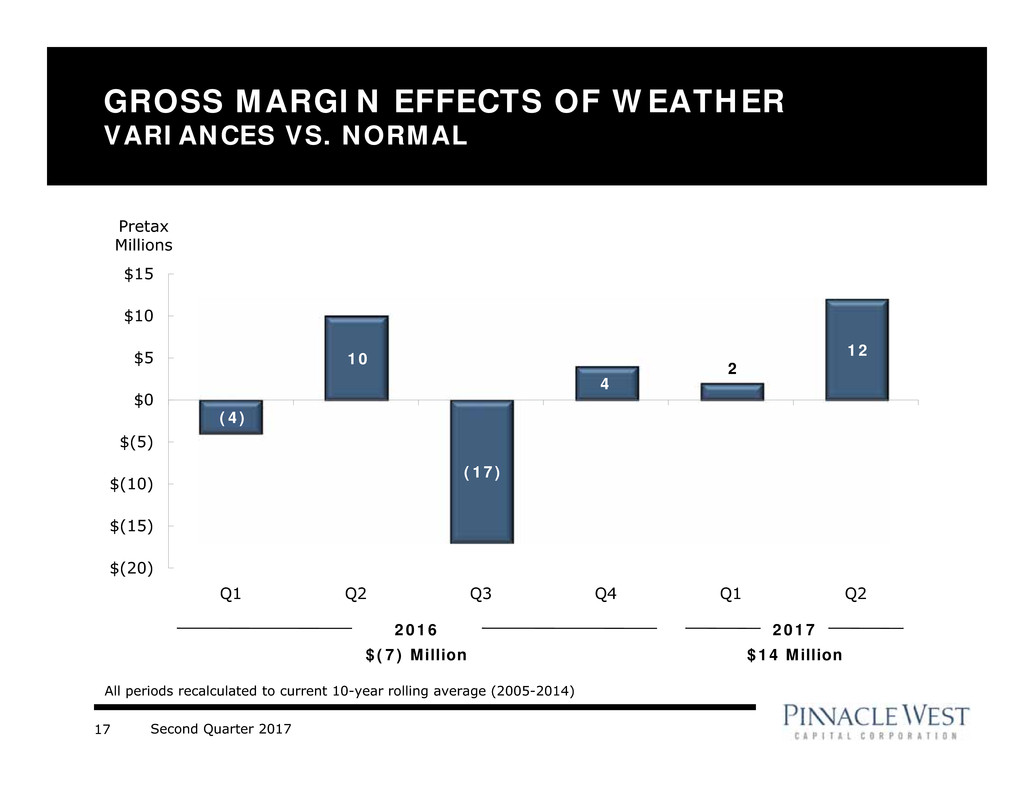
Second Quarter 201717
(4)
10
(17)
4
2
12
$(20)
$(15)
$(10)
$(5)
$0
$5
$10
$15
Q1 Q2 Q3 Q4 Q1 Q2
GROSS MARGIN EFFECTS OF WEATHER
VARIANCES VS. NORMAL
Pretax
Millions
All periods recalculated to current 10-year rolling average (2005-2014)
2016
$(7) Million
2017
$14 Million
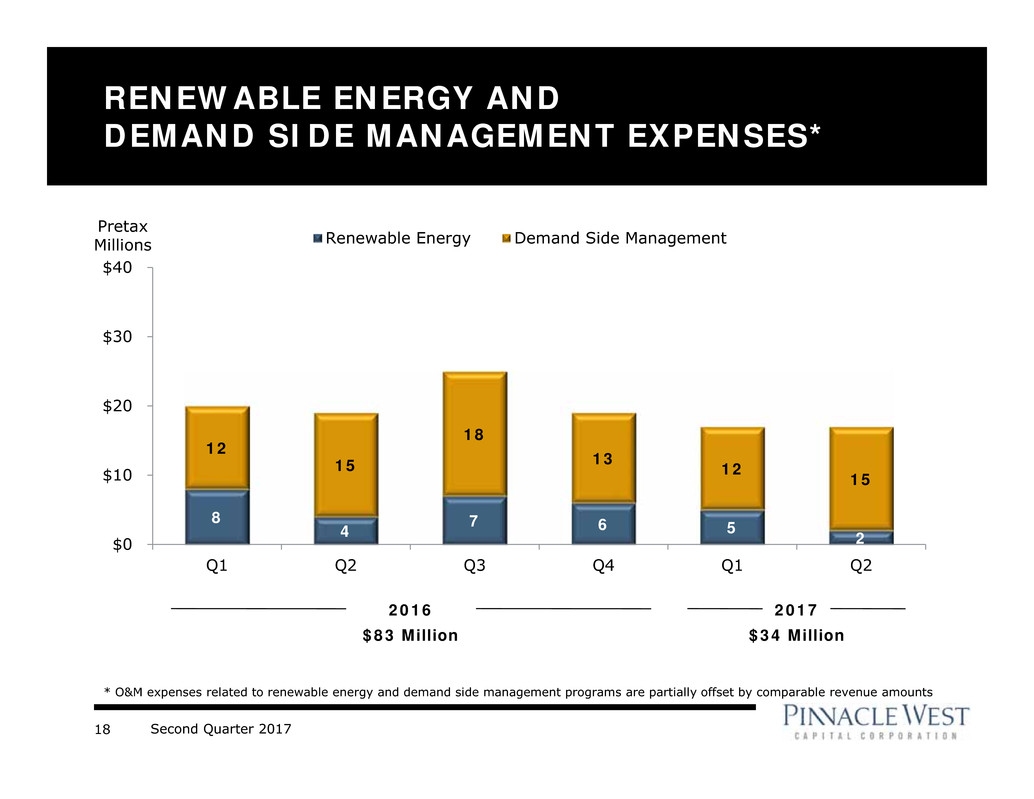
Second Quarter 201718
8
4
7 6 5
2
12
15
18
13
12
15
$0
$10
$20
$30
$40
Q1 Q2 Q3 Q4 Q1 Q2
Renewable Energy Demand Side Management
RENEWABLE ENERGY AND
DEMAND SIDE MANAGEMENT EXPENSES*
* O&M expenses related to renewable energy and demand side management programs are partially offset by comparable revenue amounts
Pretax
Millions
2016
$83 Million
2017
$34 Million
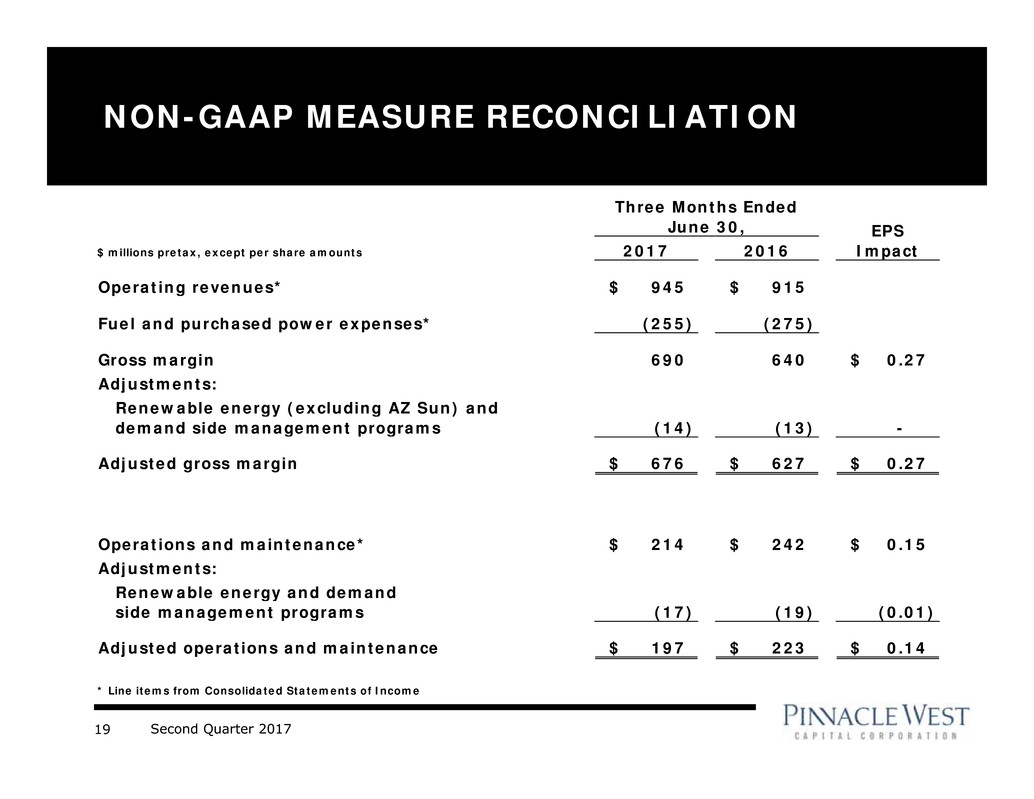
Second Quarter 201719
NON-GAAP MEASURE RECONCILIATION
$ millions pretax, except per share amounts 2017 2016
Operating revenues* 945$ 915$
Fuel and purchased power expenses* (255) (275)
Gross margin 690 640 0.27$
Adjustments:
Renewable energy (excluding AZ Sun) and
demand side management programs (14) (13) -
Adjusted gross margin 676$ 627$ 0.27$
Operations and maintenance* 214$ 242$ 0.15$
Adjustments:
Renewable energy and demand
side management programs (17) (19) (0.01)
Adjusted operations and maintenance 197$ 223$ 0.14$
* Line items from Consolidated Statements of Income
Three Months Ended
June 30, EPS
Impact

Second Quarter 201720
CONSOLIDATED STATISTICS
2017 2016 Incr (Decr) 2017 2016 Incr (Decr)
ELECTRIC OPERATING REVENUES (Dollars in Millions)
Retail
Residential 476$ 453$ 23 778$ 751$ 27$
Business 433 422 11 770 763 7
Total Retail 909 875 34 1,548 1,514 34
Sales for Resale (Wholesale) 17 20 (3) 40 40 -
Transmission for Others 11 5 6 21 14 7
Other Miscellaneous Services 6 10 (4) 10 18 (8)
Total Electric Operating Revenues 943$ 910$ 33 1,619$ 1,586$ 33$
ELECTRIC SALES (GWH)
Retail
Residential 3,445 3,313 132 5,902 5,821 81
Business 3,850 3,756 94 7,111 7,069 42
Total Retail 7,295 7,069 226 13,013 12,890 123
Sales for Resale (Wholesale) 571 943 (372) 1,645 1,938 (293)
Total Electric Sales 7,866 8,012 (146) 14,658 14,828 (170)
RETAIL SALES (GWH) - WEATHER NORMALIZED
Residential 3,359 3,246 113 5,813 5,848 (35)
Business 3,797 3,708 89 7,042 7,000 42
Total Retail Sales 7,156 6,954 202 12,855 12,848 7
Retail sales (GWH) (% over prior year) 2.9% 0.1%
AVERAGE ELECTRIC CUSTOMERS
Retail Customers
Residential 1,077,292 1,057,620 19,672 1,078,336 1,060,686 17,650
Business 133,651 131,573 2,078 133,086 131,368 1,718
Total Retail 1,210,943 1,189,193 21,750 1,211,422 1,192,054 19,368
Wholesale Customers 42 46 (4) 43 45 (2)
Total Customers 1,210,985 1,189,239 21,746 1,211,465 1,192,099 19,366
Total Customer Growth (% over prior year) 1.8% 1.6%
RETAIL USAGE - WEATHER NORMALIZED (KWh/Average Customer)
Residential 3,118 3,069 49 5,391 5,513 (122)
Business 28,404 28,181 223 52,910 53,283 (373)
3 Months Ended June 30, 6 Months Ended June 30,
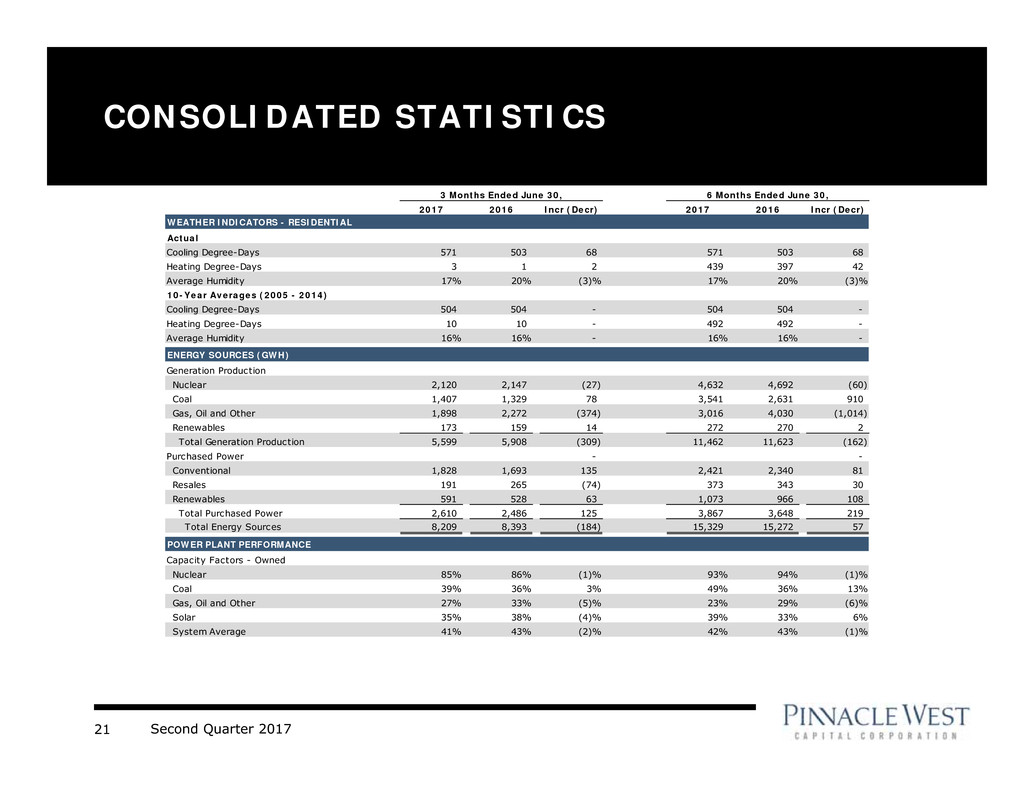
Second Quarter 201721
CONSOLIDATED STATISTICS
2017 2016 Incr (Decr) 2017 2016 Incr (Decr)
WEATHER INDICATORS - RESIDENTIAL
Actual
Cooling Degree-Days 571 503 68 571 503 68
Heating Degree-Days 3 1 2 439 397 42
Average Humidity 17% 20% (3)% 17% 20% (3)%
10-Year Averages (2005 - 2014)
Cooling Degree-Days 504 504 - 504 504 -
Heating Degree-Days 10 10 - 492 492 -
Average Humidity 16% 16% - 16% 16% -
ENERGY SOURCES (GWH)
Generation Production
Nuclear 2,120 2,147 (27) 4,632 4,692 (60)
Coal 1,407 1,329 78 3,541 2,631 910
Gas, Oil and Other 1,898 2,272 (374) 3,016 4,030 (1,014)
Renewables 173 159 14 272 270 2
Total Generation Production 5,599 5,908 (309) 11,462 11,623 (162)
Purchased Power - -
Conventional 1,828 1,693 135 2,421 2,340 81
Resales 191 265 (74) 373 343 30
Renewables 591 528 63 1,073 966 108
Total Purchased Power 2,610 2,486 125 3,867 3,648 219
Total Energy Sources 8,209 8,393 (184) 15,329 15,272 57
POWER PLANT PERFORMANCE
Capacity Factors - Owned
Nuclear 85% 86% (1)% 93% 94% (1)%
Coal 39% 36% 3% 49% 36% 13%
Gas, Oil and Other 27% 33% (5)% 23% 29% (6)%
Solar 35% 38% (4)% 39% 33% 6%
System Average 41% 43% (2)% 42% 43% (1)%
3 Months Ended June 30, 6 Months Ended June 30,
